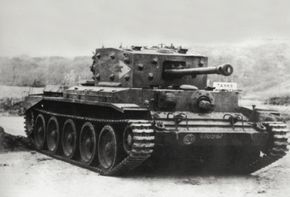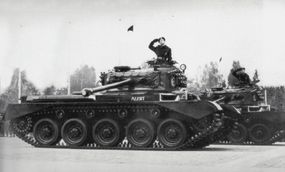The Cromwell A-27M Infantry Tank made an important contribution to British armored tactics in World War II.
By 1941 the British General Staff was convinced of the need for a tank that was faster and more heavily gunned than either the Matilda II or the Matilda II's replacement, the Churchill Infantry Tank, which could only travel at 15.5 miles per hour and was equipped with only a 40mm gun.
Advertisement
Experience in the Western Desert of North Africa showed that once enemy tanks were defeated, friendly tanks had to be able to fire high-explosive rounds in support of infantry. As a result, new specifications were published, and a fast tank useful in cavalry and infantry support roles was put into development.
Tank Image Gallery
After several false starts, the British General Staff settled on a tank design known as the Cromwell A-27M Infantry Tank. It was to be powered by the Rolls Royce Merlin engine used in the Spitfire and Hurricane fighter aircraft but detuned from 1,075 to 600 horsepower.
This was more than sufficient to move the Cromwell's 31 tons at speeds up to 40 miles per hour. This top speed was later reduced to 38 miles per hour when it was discovered that the chassis could not withstand the faster speed.
A six-pounder (57mm) gun was selected as the main armament because it was considered powerful enough to penetrate Nazi German armor in frontal attacks. But the six pounder was found to be substandard when firing a high-explosive round against troops.
The six pounder was also easily outranged by antitank gunners equipped with the 88mm antitank gun. A search was begun for a larger round and gun to provide the needed firepower.
By early 1943 the British had gained substantial experience with the American M-4 Sherman, which was equipped with a 75mm gun. The solution to the Cromwell's poor firepower was to use a gun similar to the Sherman's on the Cromwell.
It helped that ammunition was plentiful from the American Lend Lease program and from captured Vichy French (the French government that collaborated with the Nazi Germans) stocks in Syria.
The 57mm gun was bored out to accommodate the 75mm round, the barrel was shortened, and a muzzle brake was added. Two BESA 7.92mm machine guns were also mounted, one in the turret coaxial with the main gun and the other in the hull.
The limited scope of the hull machine gun made it of questionable value, and it was often left out in later production.
To learn more about the Cromwell A-27M Infantry Tank's performance, continue to the next page.
For more information about tanks and the military, see:
- Historic Tank Profiles
- How M1 Tanks Work
- How the U.S. Army Works
- How the U.S. Marines Work
Advertisement



